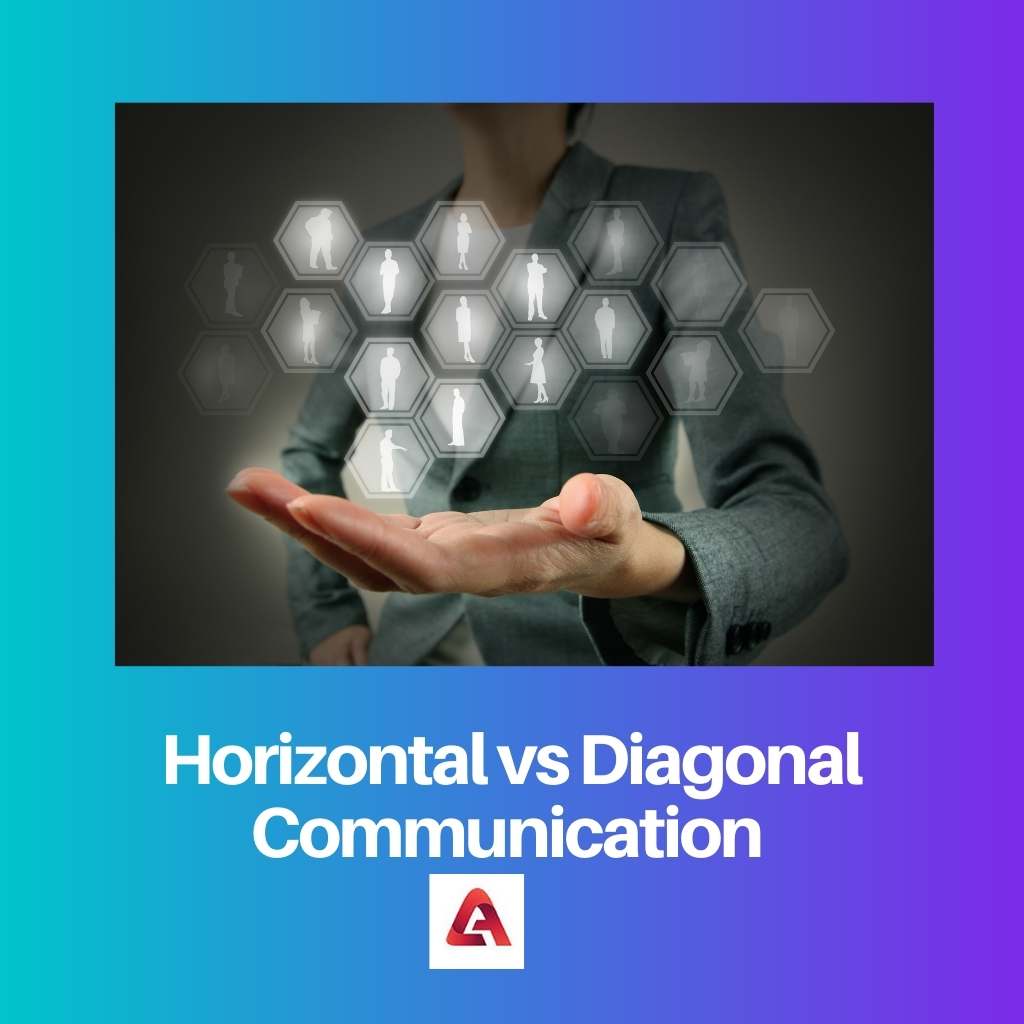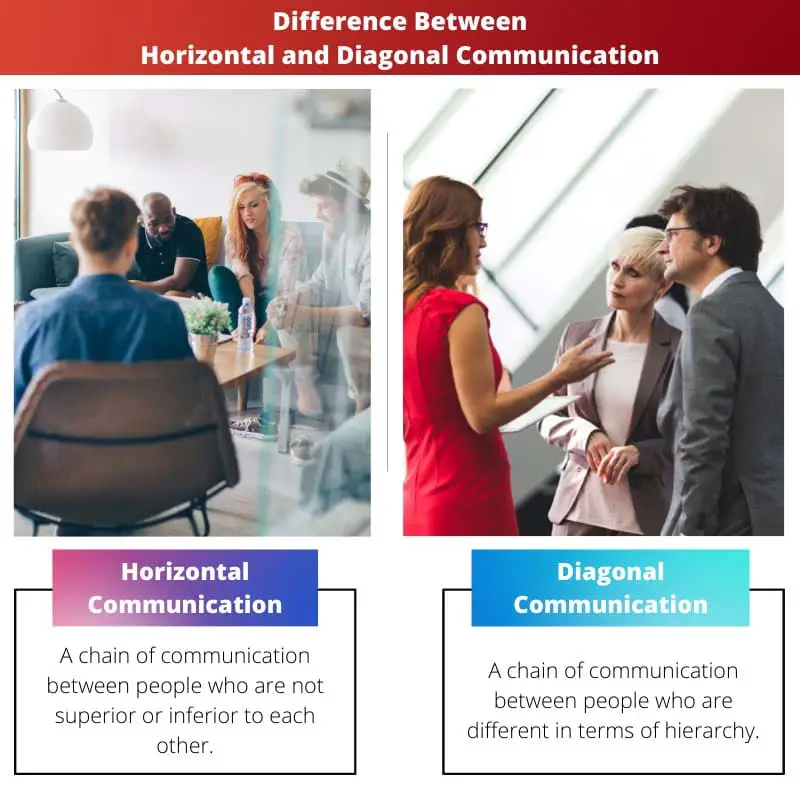There are certain ways in which communication takes place, and horizontal and diagonal communication are two examples of such ways. By the look of it, these two seem very related and similar, but the truth is that both communication flows are entirely different. It becomes very crucial for any person to be aware of the differences between these two communication channels.
Key Takeaways
- Horizontal communication occurs between employees at the same hierarchical level, while diagonal communication involves employees from different levels and departments.
- Horizontal communication fosters teamwork and collaboration, whereas diagonal communication can enhance problem-solving and decision-making.
- Diagonal communication may face more barriers due to differences in authority and expertise than horizontal communication.
Horizontal vs Diagonal Communication
The difference between horizontal and diagonal communication is that the former happens to be the kind of communication that exists between people who work at a similar level, and there is no difference in hierarchy between them. But on the other hand, the latter is a kind of communication that occurs between people situated at entirely different stages of the hierarchy. Apart from this very cool difference, other differences, such as the purpose of these two communications and their impact, can also be marked.

Horizontal communication can be interpreted by its name very easily. It represents a chain of communication that can be seen between people who work at a level where similar positions are situated. An example can better understand this veer a chain of communication is taking place between students of the same class. This communication shall be labelled as horizontal communication as there is no difference in hierarchy between these students, and all of them are at the same level.
But on the other hand, vertical communication exists between those people who work at different levels of hierarchy in any organization. For example, if the Dean of the university communicates to the head of the department and then the head of the department communicates to the peon, this chain of communication shall be referred to as vertical communication as it does not involve people who are working at the same level rather involves people who are working at an entirely different level and thus shows a chain of hierarchy as well.
Comparison Table
| Parameters of Comparison | Horizontal Communication | Diagonal Communication |
|---|---|---|
| Meaning | a chain of communication between people who are not superior or inferior to each other | a chain of communication between people who are different in terms of hierarchy |
| Purpose | By this particular communication people share general information | By this particular communication people either seek to clear their doubts or give authoritative decisions |
| Tone of communication | this particular communication holds a sort of informal tone | this communication happens to be very formal |
| Means of communication | This communication is mostly done orally | this communication takes place in writing necessarily |
| Possibility of misinterpretation | due to being a shorter channel the probability of destruction of the exact message is comparatively low | due to being a lengthy channel, there is a probability of the message being misinterpreted |
| Length of the channel | the channel of this particular communication happens to be a shorter one as the information flows between two people mainly | the channel of this communication can be very lengthy as it involves many people at many levels |
What is Horizontal Communication?
The term horizontal represents anything that exists on a similar line, and the meaning of horizontal communication can easily be inferred from the definition of horizontal itself. In other words, Horizontal communication is basically a channel of communication that exists to ease the process of information exchange between those who are situated at a similar level of hierarchy.
This channel works between informal relations and is mostly used by orally speaking and receiving the message. This is the reason this channel is relatively short, as it only involves the person who is sending the message and the person who is receiving the message.
A very distinguished advantage of this channel is that because of is a short one, the reliability of the message can be granted very easily as there is a very less probability of a message being distorted. People use this channel to inform others about general ideas and daily progress.

What is Diagonal Communication?
The term diagonal is a synonym for the term vertical and represents anything between cross-sectional levels. In other words, it represents a channel of communication between people situated at different levels of hierarchy in a given workplace.
They communicate with each other in a very formal tone, and this particular conversation is recorded in the form of writing mostly for fun people use the channel of dialogue communication because of the fact that it seeks to improve the authority and the chain of command in a particular organization.
A big disadvantage of this particular channel is that due to being a lengthy channel, there is a probability of the message being misinterpreted because many people happen to be involved in the channel, and this involvement can become the cause behind the misinterpretation of data.
However, a particular advantage is also associated with this channel: the clear-cut division of authority and obeyance. This channel ensures that all people become aware of their exact responsibilities while learning to respect their superiors as well.

Main Differences Between Horizontal and Diagonal Communication
- The term Horizontal Communication represents a chain of communication between people who are not superior or inferior to each other, but on the other hand, the term Diagonal Communication represents a chain of communication between people who are either superior to certain people or inferior to certain people in terms of hierarchy.
- The tone of Horizontal Communication happens to be a bit informal as compared to Diagonal Communication because of the involvement of people.
- Horizontal Communication can easily be done orally, but in the case of Diagonal communication, it should only take place in due writing.
- Diagonal Communication is a relatively lengthy channel as compared to a Horizontal one.
- In horizontal communication, very few people are involved; thus, the probability of a message being misinterpreted is comparatively low than in the Diagonal channel of communication.

- https://www.jstor.org/stable/2390677
- https://journals.sagepub.com/doi/abs/10.1177/108056990206500202

The distinction in the tone and means of communication between horizontal and diagonal communication is important for understanding the formality and clarity associated with these channels. The comparison provides valuable insights.
I agree, the formality of diagonal communication due to its written nature impacts how information is conveyed throughout an organization.
The examples used to illustrate horizontal and diagonal communication are effective in providing a tangible understanding of these concepts. This article provides a comprehensive comparison of these communication channels.
The distinction between horizontal and diagonal communication is crucial for understanding organizational dynamics and interpersonal relationships within a workplace. The clear definition of these types of communication channels is very insightful.
The distinction between horizontal and diagonal communication in terms of authority and hierarchy is enlightening. Understanding these differences is crucial for effective communication strategies within an organization.
The clear-cut division of authority and responsibility in diagonal communication and its impact on organizational dynamics is an important aspect to consider for managers and leaders in various industries.
The comparison table provided in the article offers a concise yet thorough overview of the differences between horizontal and diagonal communication. It serves as a useful reference point for understanding these channels.
The explanation of horizontal and diagonal communication as distinct channels with specific characteristics and implications is valuable for understanding how information flows within an organization.
The advantages and disadvantages of both horizontal and diagonal communication are well articulated, providing a comprehensive understanding of their impact on organizational communication.
The clarity on the length of the communication channels and how that affects the potential for misinterpretation is a key consideration for organizations aiming to improve communication.
The purpose and tone of both horizontal and diagonal communication are well-explained. The difference in the means of communication and the possibility of misinterpretation between the two channels is an important consideration in organizational contexts.
The potential for misinterpretation in diagonal communication due to its lengthier nature and involvement of multiple people is a key challenge that organizations need to address.
I agree, the clear distinction in purpose and tone between the two types of communication is essential for effective use in different organizational contexts.